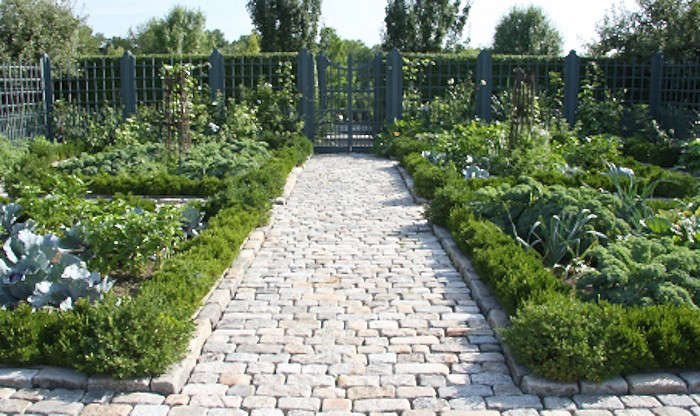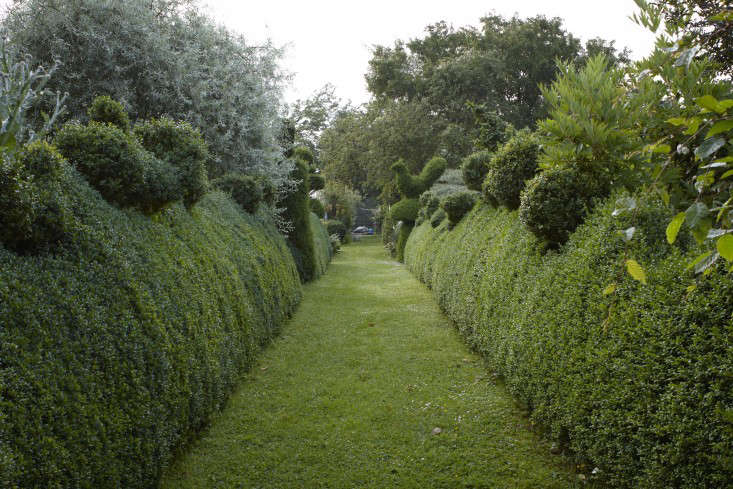When you hear the word boxwood, do you think Versailles? In that French feat of landscaping splendor, boxwood is clipped and pruned and trained into submission, as hedges and edging and even tapestries. But this shrub known for its obedient nature and pleasantly pungent scent can easily make itself at home in all sorts of gardens. Here’s a sampling:
Above: Photograph courtesy of Janice Parker Landscape Architects.
To create pattern and texture in a landscape, “I have no problem with mixing curves and straight edges,” says landscape architect Janice Parker. “If you’re going to go for it, go big or go home.”
For more of her work, see Ask the Expert: 8 Ways to Add Pattern to a Landscape with Janice Parker.
Above: Photograph by Nicole Franzen for Gardenista.
In Mill Valley, California architect Barbara Chambers relies on boxwood balls to create symmetry in her back garden. For more of her garden, see Architect Visit: Barbara Chambers at Home in Mill Valley.
Above: Photograph by Kendra Wilson. For cloud pruning perfection, the gardeners at Cottesbrooke rely on English Gardeners’ Favorite Tools: Niwaki Tripod Ladder.
Above: Who needs flowers when you have 50 shades of green? The late British interior designer David Hicks planted his romantic garden at The Grove, in Oxfordshire. Here, topiarized boxwood grows in bottomless containers that reduce the need to water. “The inspiration was mainly labor-saving,” says Hicks’s son, designer Ashley Hicks, “but also to give a look of orange trees at Versailles, albeit on a slightly smaller scale.” Read more in Brit Style: The Garden With (Almost) No Flowers. Photograph by Kendra Wilson.
Above: A looser topiarized look can also work, as shown by the slightly shaggy boxwood hedges at Dan Pearson’s Old Rectory, in the heart of a Cotswolds village. Elsewhere on the property, blowsy wildflower meadows attest to what the designer calls his “relaxed and naturalistic” approach.
Above: Photograph courtesy of Andrea Filippone.
Influenced by French garden designs, landscape designer Andrea Filippone laid out her vegetable garden in a grid, each perfect square edged with box. For more of her garden, see The Garden Designer is In: A Deer-proof Edible Garden.
Above: At his garden in Garrison, NY, interior designer Juan Montoya capitalized on boxwood’s sculptural quality and deep green hue. Boxwood could be considered too formal for this type of landscape, but Mntoya dotted large areas in a seemingly random pattern that adds visual interest. Read more in Garden Visit: La Formentera in Garrison, NY. Photograph by Eric Piasecki.
Above: We love this well-proportioned townhouse garden in Brooklyn, where Susan Welti of Foras Studio clipped boxwood into balls and a cube. She added other plants that can withstand city heat: Solomon’s seal, Russian sage, Mexican feather grass, and hydrangeas. For more of this garden, see Modern Brooklyn Backyard on a Budget.
Above: Photograph by Britt Willoughby Dyer for Gardenista.
In recent years, this beloved garden standby has become susceptible to a fungal disease called box blight, especially in England. Many gardeners are giving up and replacing their box with something hardier. Though it may seem like admitting defeat, we offer this advice in How to Eliminate Boxwood Blight: Plant a Different Shrub. But many boxwood lovers remain steadfast in their support, armed with chemical fungicide–and hope.
Finally, get more ideas on how to successfully plant, grow, and care for boxwood with our Boxwood: A Field Guide.
Finally, get more ideas on how to plant, grow, and care for various shrubs and hedges with our Shrubs: A Field Guide.





















Have a Question or Comment About This Post?
Join the conversation (0)